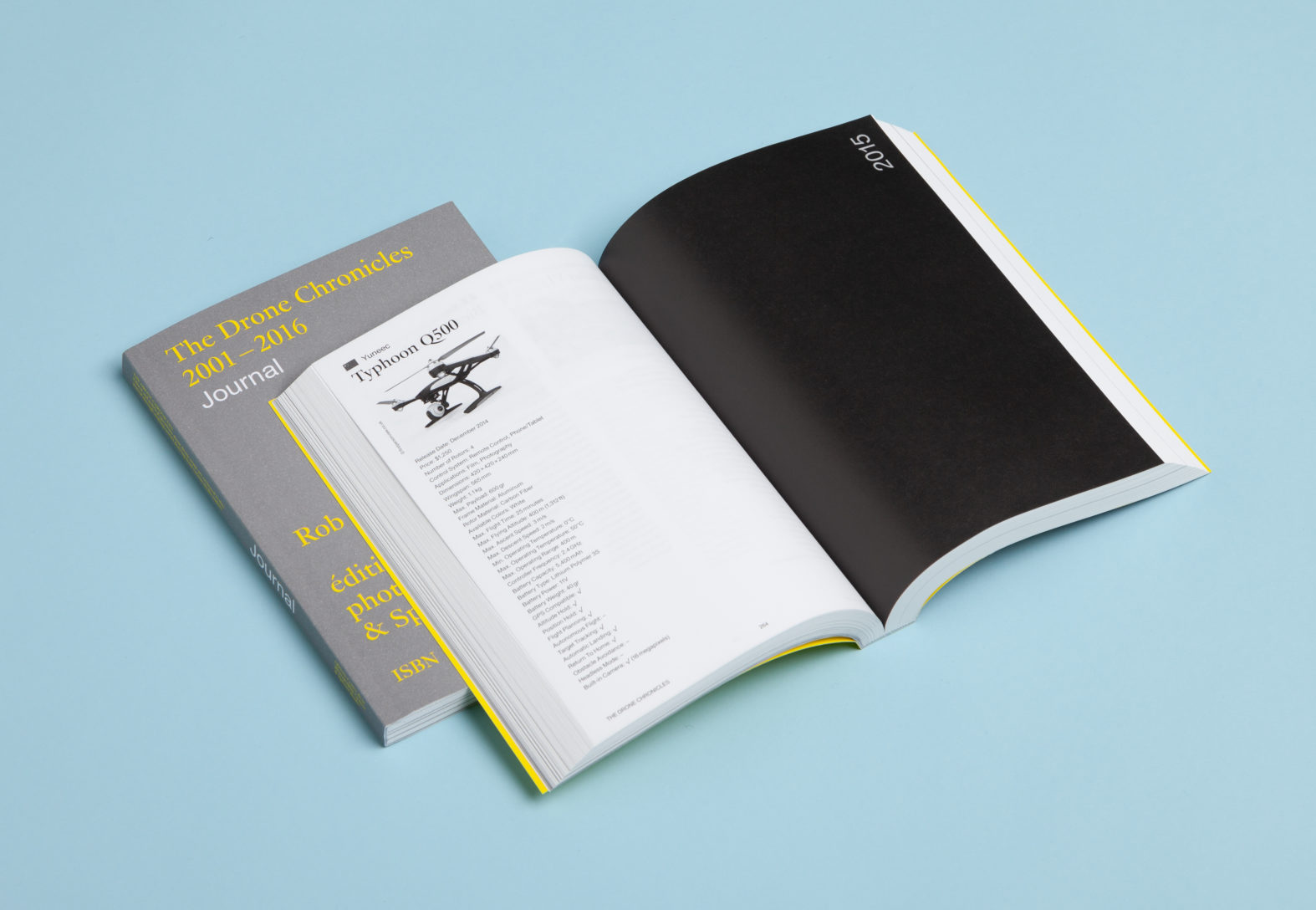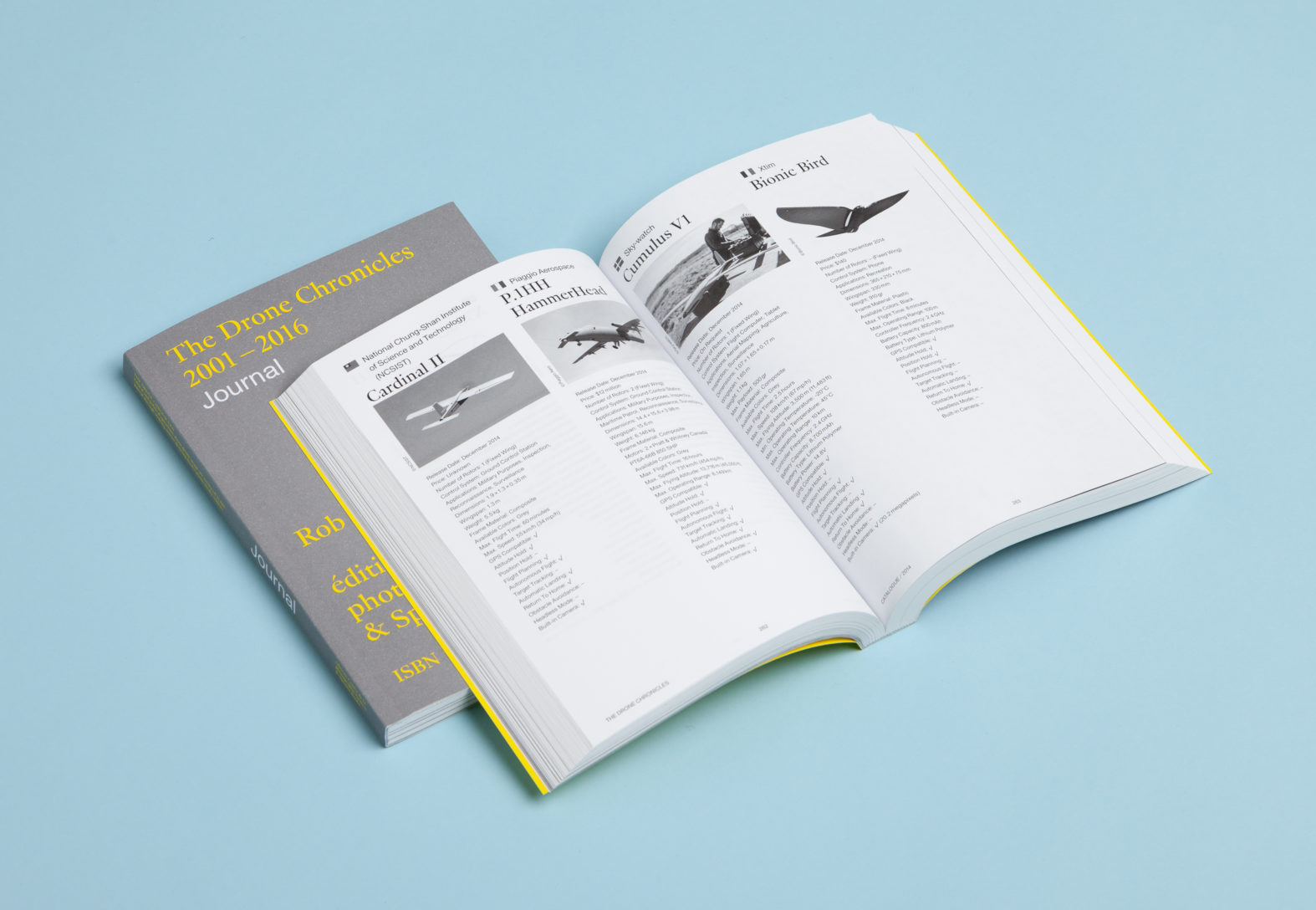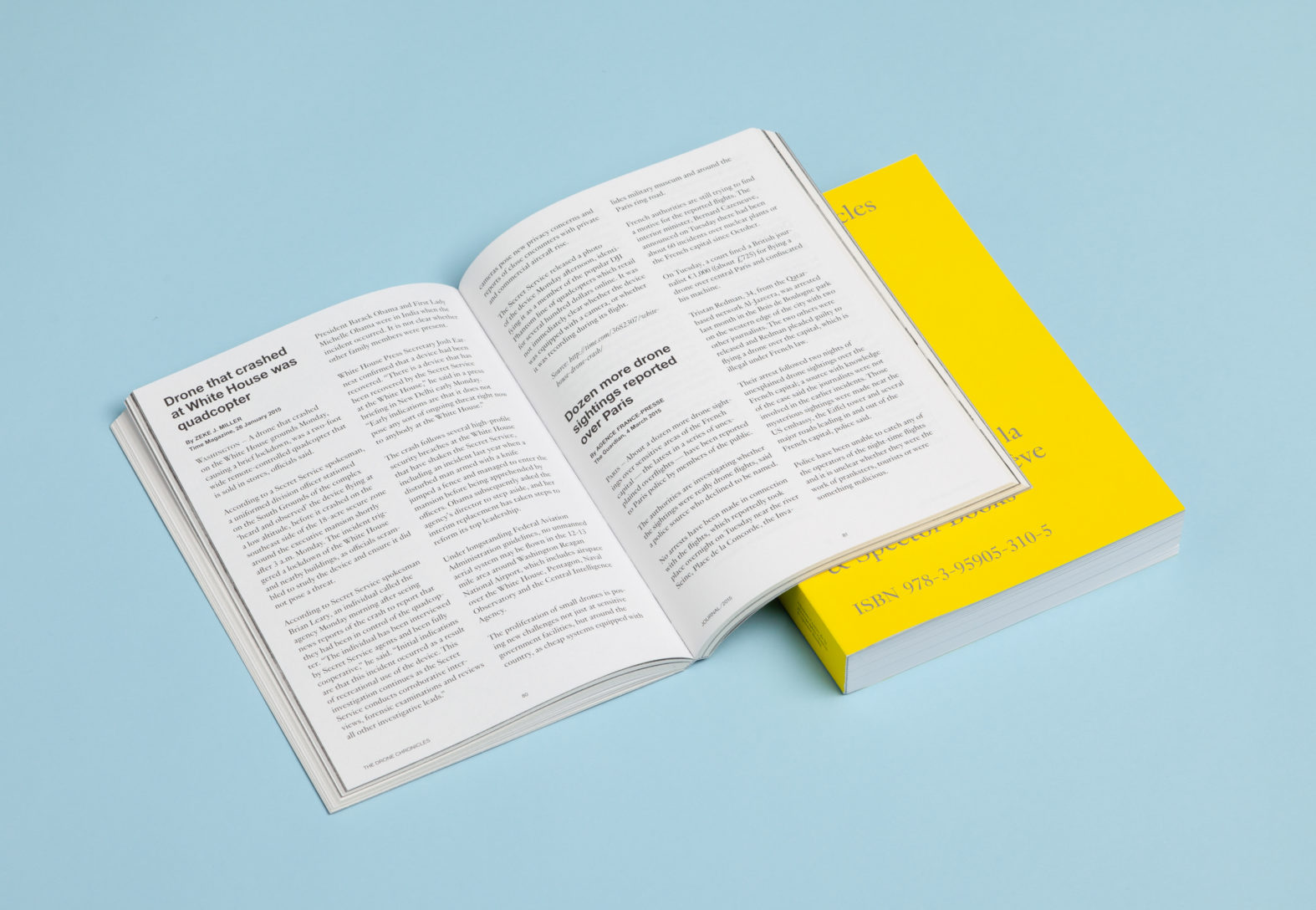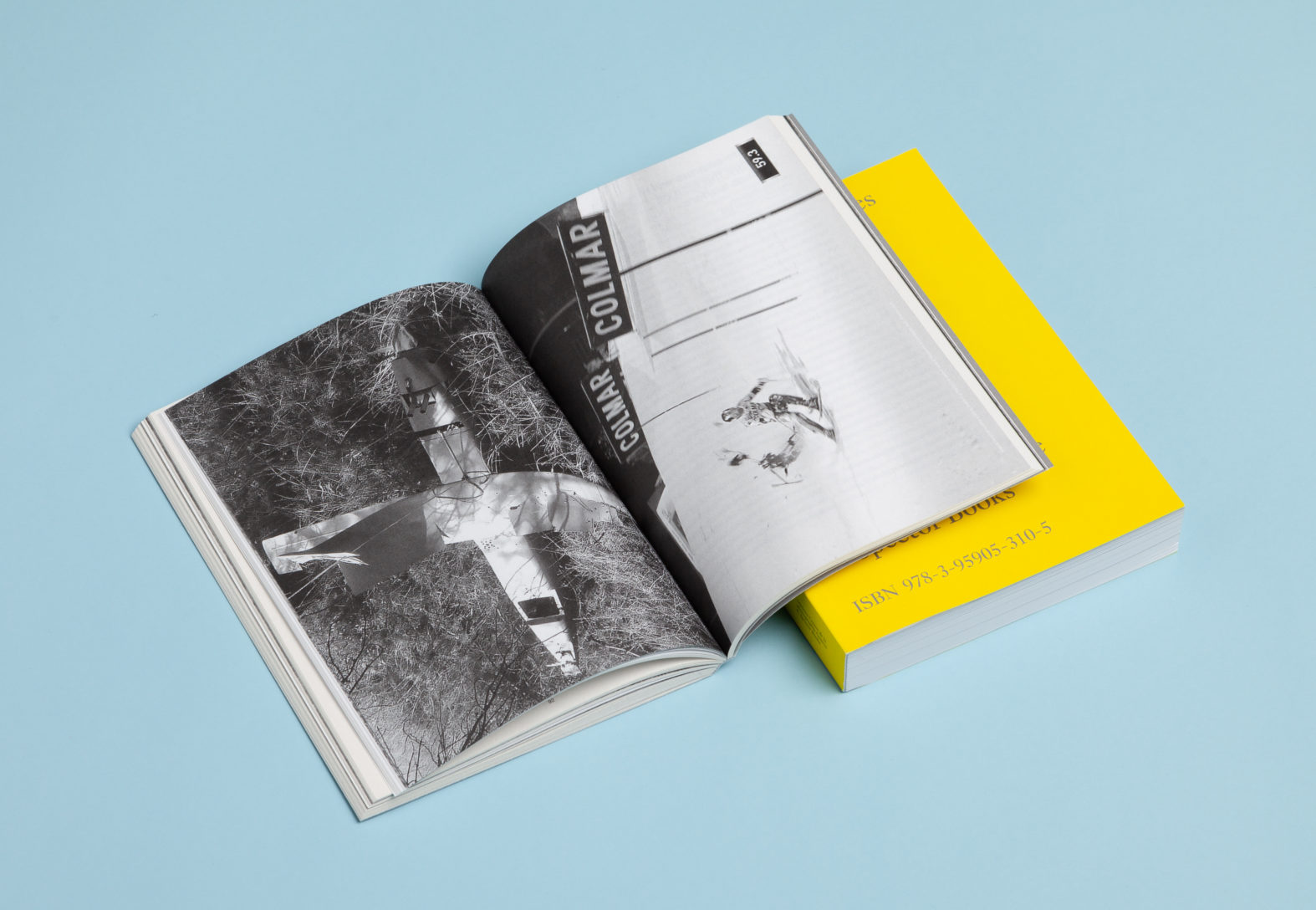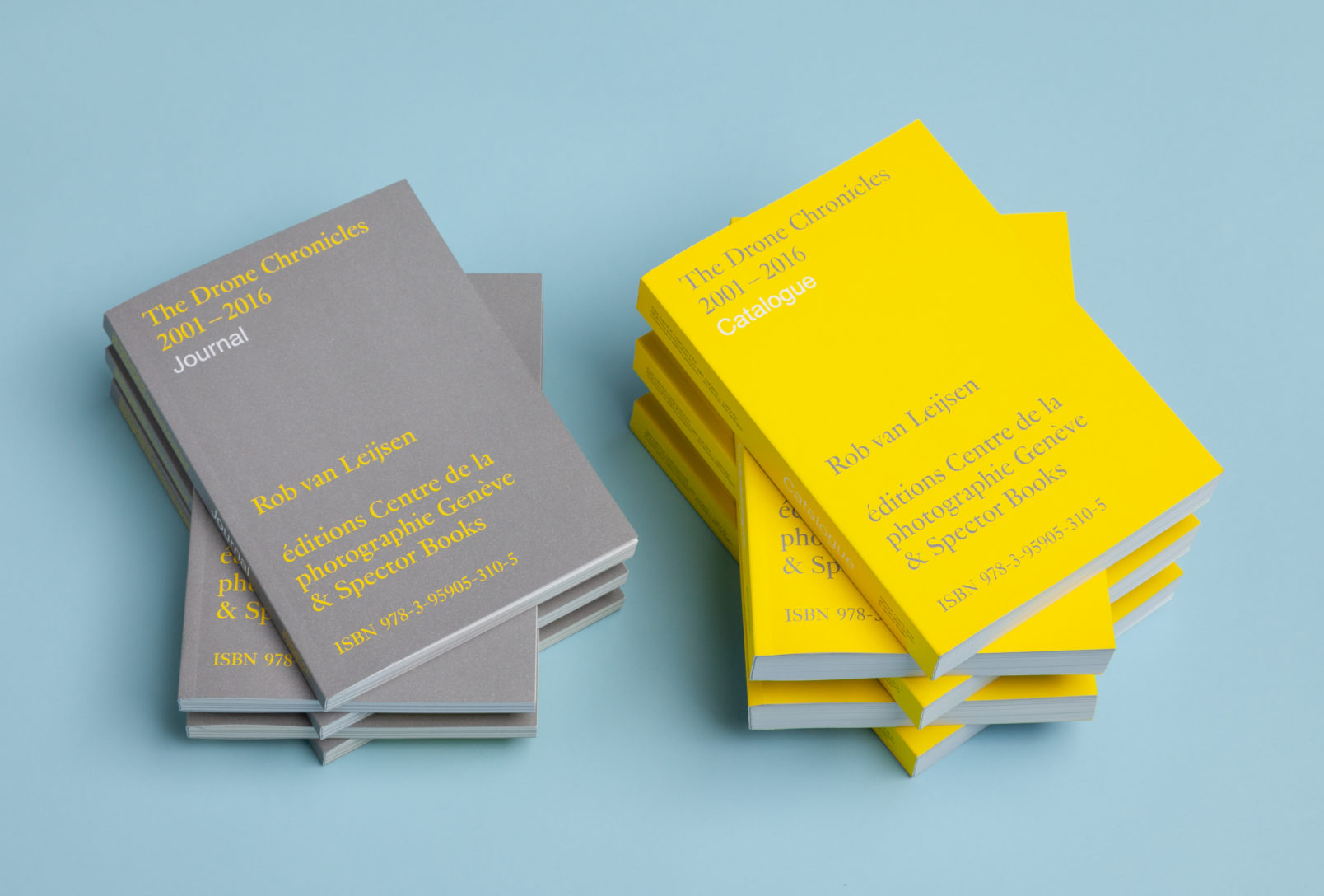Rob van Leijsen, designer
The Drone Chronicles 2001-2016, published by éditions CPG & Spector Books, 2019
Why are drones — or unmanned aerial vehicles (UAV) — so present in our daily news feed and local retail stores, but do we — despite sky-high sales numbers — hardly see them fly in our public airspace? This paradox of invisible presence lies at the basis of The Drone Chronicles, an editorial diptych that maps the evolution and integration of drones in our society from 2001 onwards. As a drone surveilling a battlefield or crowd, the book offers a contemporary view on drones without emphasising a particular category or usage. It discusses how this relatively new piece of technology has shifted from a commonly known aerial bombing machine to a multipurpose and accessible tool. The endless applications and several utterly striking stories involving drones are highlighted in the journal. All selected articles derive from various international media outlets, in which ethical and political questions about drone usage are reviewed from different perspectives. The extensive catalogue questions the exponential production of drones. All models introduced to the market between 2001 and 2016 — either for commercial or military purposes —, are organised by release date, manufacturer and name, and characterised by their technical specifications. The manufacturers are listed by country in the catalogue’s index, proposing a geopolitical comparative reading, equal to that of an atlas.
Rob, in which fields of knowledge are you focused?
In my visual research practice I focus on various parts of human society. They include the arts, human science and technology. Subjects are emerging from personal curiosities or urgent questions from the public domain
What is the object of your research?
In the case of The Drone Chronicles, the objective was to investigate the integration and evolution of drones in our society by archiving and structuring all produced drones between 2001 and 2016 and selecting some of the key events from that timespan that involved drones. The resulting editorial diptych shows the shift of the drone as a commonly known aerial bombing machine to a multi-purpose and accessible tool.
Could you identify some constants in your work?
My projects always tend to show the hidden and underexposed aspects of my subject by structuring the content in a specific manner. I handle a very analytical and observing working method. By searching unexpected encounters within subjects the outcome should propose a whole new, supplementary narrative. The Drone Chronicles is about technological evolution and human adaptation, but geo-politics and consumerism are also much legible because of the way the content is presented. In Art Handling in Oblivion I explored the condition of art collections in wartime, two very distinct subjects at first sight.
How did you find out about Aby Warburg’s work?
I first got in touch with Warburg’s work through his Mnemosyne Atlas, the project for which he is best known I guess. I mainly retain the impact that the categorisation of his atlas had on me. I experienced it as something extremely precise and quite directive, although it leaves enough room for interpretation by the reader. It shows that by editing one can distract, guide or steer the reader in a specific direction, even when the source material is deriving from various archives and historical eras.
How would you define an Atlas?
A traditional atlas informs about borders, distances, and resources. It has a strong geographic consensus and is much about opposition and global differences. If we turn away from pure geography and take a conceptual turn on the atlas structure, for me it has to offer a comprehensive comparison of content of all sorts. An atlas wants to set out an argument or take a stance by arranging a pile of information. In doing so, it proposes a voyage through the selected content.
Do you know about the existence of Mnemotechnics?
To be honest this is relatively new to me. I won’t say I know the subject of Mnemotechnics very well. But without knowing the theory I seem to use it quite a lot.
Which mnemonic system guides the organization of your material?
This is definitely the note organization mnemonics (as described in Wikipedia). Lists are a substantial part and important method to shape my ideas. A list is a unique comparative research tool. They seem solely factional and objective, but the more elements and items they contain, the more they reveal.
Are there visual and emotional formulas (pathosformeln) in your project?
I won’t say there are any in The Drone Chronicles. The timespan is from 2001 till 2016, so I won’t consider the early material “historical” or from “old times”. My previous book Art Handling in Oblivion is full of pathosformel, where works of art from multiple eras are re-contextualised.
In your work, do you identify formal or conceptual recurrences such as repetitions and disruption, distance and proximity, identity and migration, conflict and colonization?
Some of the conceptual recurrences are geopolitics and conflict. It is not on purpose but in the end my research subjects have much to do with conflict. I see conflict as a space where nations, institutions and corporations show their core interests, and can therefore be more easily analysed.
In your work, what is the balance between image and text?
An image is often illustrating or proving an hypothesis already underlined by lists and texts. Images are important to contextualise the project and draw the reader to the texts. One has to be very careful with the choice of images, especially when it concerns source material. Images have an aesthetic value but could contain information that goes against key arguments of the editorial project. In the case of the catalogue of The Drone Chronicles, the choice to print in black/white was an economic decision as well as an attempt to unify the images of the drones that came from an enormous variety of sources. In that way the shapes of the models were well visible, without information of patterns and surroundings calling for attention.
Thinking about Warburg’s ‘good neighborhood rule’, what are the books that underpin your project?
Drone Theory, Grégoire Chamayou, Penguin
Flower Colour Guide, Darroch and Michael Putnam, Phaidon
Before and After – Documenting the Architecture of disaster, Eyal and Ines Weizman, Strelka Press
The Archive as a Productive Space of Conflict, Markus Miessen & Yann Chateigné, Sternberg Press
Parallel Encyclopedia, Batia Suter, Roma Publications
Labyrinth – Four times through the labyrinth, Olaf Nicolai & Jan Wenzel, Spector Books & Rollo Press
The Whole Earth Catalogue, Steward Brand, The Portola Institute
Rob van Leijsen is a multidisciplinary graphic designer based in Geneva, Switzerland. His design practice mainly aims at commissioned projects in the cultural field, notably editorial design. He currently runs his own design studio and teaches at the visual communication department of HEAD – Genève. Besides commissioned projects, he initiates research projects that offer reflections on society. The publication The Drone Chronicles, documenting the evolution of drones (éditions CPG & Spector Books, 2019), is his most recent title. In 2012 he finished his master in Design Space & communication at HEAD – Genève with Art Handling in Oblivion, a catalogue that assembles five art collections that have been stolen during wartime. Art Handling in Oblivion was further edited and published with edition fink in 2014. A research about facsimile artists’ books titled Copy, Tweak, Paste: Methods of Appropriation in Re-enacted Artists’ Books is forthcoming as a bilingual publication in 2020.
